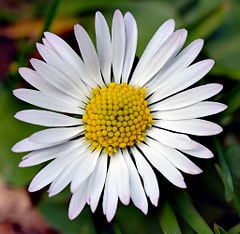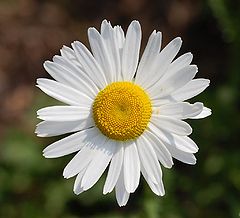Daisy
| Daisy | ||||||||
|---|---|---|---|---|---|---|---|---|
 English or true daisy (Bellis perennis)
| ||||||||
| Scientific classification | ||||||||
| ||||||||
|
See text |
Daisy is the common name for several plants in the Asteraceae (or Composite) family, and in particular the true or English daisy (Bellis perennis) and the oxeye daisy (Chrysanthemum leucanthemum or Leucanthemum vulgare). Daisy are characterized by the star-shaped flower head, consisting of a densely packed cluster of numerous, small, individual flowers (florets). Both of these species have a center composed of yellow disc florets surrounded by ray florets with long, white petals. In addition, the entire family sometimes is known as the daisy family.
Overview and description
The family Asteraceae or Compositae, to which Chrysanthemum belongs, is known as the aster, daisy, or sunflower family. It is the largest family of flowering plants in terms of number of species. According to the Royal Botanical Gardens of Kew, the family comprises more than 1,600 genera and 23,000 species. The name "Asteraceae" is derived from the type genus Aster and refers to the star-shaped flower head of its members, epitomized well by the daisy. "Compositae," an older but still valid name (McNeill et al. 2006), means "composite" and refers to the unique inflorescence (described below).
Asteraceae is a taxon of dicotyledonous flowering plants. In addition to the chrysanthemum and daisy, other well-known members of the family include lettuce, chicory, globe artichoke, safflower, dandelion, ragwort, and sunflower.
Plants belonging to the Asteraceae share all the following characteristics (Judd et al. 1999). None of these traits, taken separately, can be considered synapomorphic.
- The inflorescence is an involucrate capitulum (flower head)
- Tubular/disc florets are actinomorphic, ligulate/ray florets are zygomorphic
- Anthers are syngenesious, i.e. with the stamens fused together at their edges, forming a tube
- The ovary has basal arrangement of the ovules
- One ovule per ovary
- The calyx (sepals) of the florets are modified to form a pappus, a tuft of hairs, which often appears on the mature fruit
- The fruit is an achene
- In the essential oils Sesquiterpenes are present, but iridoids are lacking.
The most common characteristic of all these plants is an inflorescence or flower head (formerly composite flower): a densely packed cluster of numerous, small, individual flowers, usually called florets (meaning "small flowers"). Plants in the family Asteraceae typically have one or both of two kinds of florets. The outer perimeter of a flower head like that of a sunflower is composed of florets possessing a long strap-like petal, termed a ligule; these are the ray florets. The inner portion of the flower head (or disc) is composed of small flowers with tubular corollas; these are the disc florets.
Common daisy
Bellis perennis is a common European species of Daisy, often considered the archetypal species of that name. Many related plants also share the name "Daisy", so to distinguish this species from other daisies it is sometimes qualified as Common Daisy, Lawn Daisy or occasionally English daisy. It is native to western, central and northern Europe. The species is widely naturalized in North America, where it is considered an invasive weed.
It is a herbaceous plant with short creeping rhizomes and small rounded or spoon-shaped evergreen leaves 2–5 cm long, grows close to ground. The flowerheads are 2–3 cm in diameter, with white ray florets (often tipped red) and yellow disc florets; they are produced on leafless stems 2–10 cm (rarely 15 cm) tall. The lawn daisy is a dicot.
Oxeye daisy
The oxeye daisy (Leucanthemum vulgare, syn. Chrysanthemum leucanthemum), also known as the marguerite, is a widespread flowering plant native to Europe and the temperate regions of Asia. It is one of a number of plants to be called by the common name daisy. It is also sometimes called moon daisy or dog daisy.
It is a perennial prostrate herb with small flower head (not larger than 5 cm) that consists of about 20 white ray flowers and numerous yellow disc flowers, growing on the end of the stem. The stem is mostly unbranched and sprouts laterally from a creeping rootstock.
The leaves are darkgreen on both sides. The basal and middle leaves are petiolate, obovate to spoon-shaped, and serrate to dentate. The upper leaves are shorter, sessile and borne along the stem.
It produces an abundant number of flat seeds without pappus. It spreads also vegetatively by rooting underground stems.
The oxeye daisy is a typical meadow flower, growing in a variety of plant communities such as dry fields, meadows, but also under scrubs, open-canopy forests and waste places. It thrives in a wide range of conditions and prefers heavy and damp soils. It was introduced in parts of North America, Australia and New Zealand, where it is now a common weed displacing native plant species in some areas. It is difficult to control or eradicate, since a new plant can regenerate from rhizome fragments. However, in North Carolina it is planted on roadsides by the highway department.[1]
Etymology
It is thought that the name "daisy" is a corruption of "day's eye", because the whole head closes at night and opens in the morning. Chaucer called it "eye of the day".
Daisy is also a common girl's name and is a nickname for girls named Margaret, which originally comes from the Latin word for daisy.
Uses
It is not affected by mowing and is therefore often considered a weed on lawns, though many also value the appearance of the flowers. Several cultivars and hybrids have been selected with much larger flower heads up to 5–6 cm diameter and with light pink to purple-red ray florets.
Bellis perennis has astringent properties and has been used in folk medicine.[2]
Green leaves are edible, consume moderately.
It has traditionally been used for making daisy chains as a children's game.[3]
Gallery
- Daisy's eye view.jpg
- Bellis perennis dsc00906.jpg
- Bellis perennis Marburg 01.jpg
- Daisy flower.jpg
- Field of daisies.jpg
- Sa Daisy flower.jpg
Daisy flower extreme close-up
- Daisy900ppx.jpg
ReferencesISBN links support NWE through referral fees
- ↑ "Wildflowers Find Favor With Highway Gardeners" article by Felicity Barringer in the New York Times August 29, 2007
- ↑ Howard, Michael. Traditional Folk Remedies (Century, 1987), p129
- ↑ Children's 'right to play'. BBC News. BBC (2002-08-07). Retrieved 2008-11-02.
External links
- Bellis perennis (USDA plant profile)
Credits
New World Encyclopedia writers and editors rewrote and completed the Wikipedia article in accordance with New World Encyclopedia standards. This article abides by terms of the Creative Commons CC-by-sa 3.0 License (CC-by-sa), which may be used and disseminated with proper attribution. Credit is due under the terms of this license that can reference both the New World Encyclopedia contributors and the selfless volunteer contributors of the Wikimedia Foundation. To cite this article click here for a list of acceptable citing formats.The history of earlier contributions by wikipedians is accessible to researchers here:
The history of this article since it was imported to New World Encyclopedia:
Note: Some restrictions may apply to use of individual images which are separately licensed.


